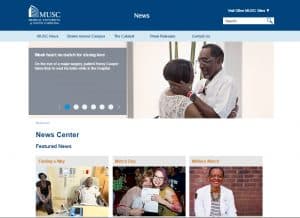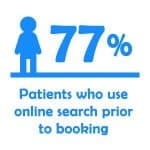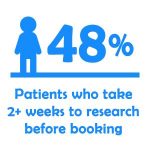
Is Content Marketing a Cure-All for the Hospital Industry?
IS CONTENT MARKETING A CURE-ALL FOR THE HOSPITAL INDUSTRY?
What if you could implement one marketing strategy that ties together other strategies, increases patient trust, extends return on investment, and connects directly with target audiences? Effective content marketing can do all of this, and more. While it might not be a miracle pill for the hospital industry, it comes close.
It is difficult to overlook the presence of content marketing across industries and disciplines. Not only are the majority of industries engaging in it at some level, 81 percent have established strategy devoted to content  development, creation, and dissemination. Despite this, hospitals have historically lagged behind other industries in their efforts. Below are four excellent reasons your hospital needs to take the plunge and implement a content marketing strategy today.
development, creation, and dissemination. Despite this, hospitals have historically lagged behind other industries in their efforts. Below are four excellent reasons your hospital needs to take the plunge and implement a content marketing strategy today.
Reason 1: Content marketing shapes overall marketing strategy.
The concept of content marketing is predicated on the idea of developing valuable content tailored to engage a specific audience. According to Scott Linabarger, former senior director of multichannel content marketing for the Cleveland Clinic, “In many respects, health care is tailor-made for content marketing. Consumers are highly interested in their health and are often voracious consumers of information that will prevent or solve problems and enhance their quality of life.”
Linabarger was instrumental in the development of the Cleveland Clinic’s Health Essentials website, established in 2015 as Health Hub. Health Essentials provides a virtual information center where patients can read about topics ranging from medical conditions, to common health questions, to diet and fitness. Here, people can find  recipes for arugula salad or learn how to help children cope with parental divorce. In 2014, the American Marketing Association recognized the initiative as the best of healthcare content marketing.
recipes for arugula salad or learn how to help children cope with parental divorce. In 2014, the American Marketing Association recognized the initiative as the best of healthcare content marketing.
While content satisfies audiences’ appetite for health-related information, it is also a highly effective vehicle for organizational branding, advises Heather Woolwine, public affairs and media relations director for the Medical University of South Carolina (MUSC). “Content marketing allows you to tell your story the way you want it to be told, rather than being at the mercy of journalists to portray the information accurately, and with complete context,” Woolwine says.
The MUSC News Center provides news and information about recent developments and initiatives on campus and in clinics, tying national trends to local happenings and vice versa. It creates a narrative approach to news items  like “Weak Heart No Match for Strong Love,” chronicling a patient’s in-hospital wedding while awaiting major heart surgery. Media and patients alike are drawn to the site, and articles often provide the bases for future media coverage.
like “Weak Heart No Match for Strong Love,” chronicling a patient’s in-hospital wedding while awaiting major heart surgery. Media and patients alike are drawn to the site, and articles often provide the bases for future media coverage.
Reason 2: Content marketing affects patient trust.
A collaborative study by Google and market research-firm, Compete, found 77 percent of patients use online search to find a healthcare provider. These patients are far more likely to begin their journey by seeking information on a disease or symptom than by searching for a particular facility or brand. This underscores the power of well-developed content. “Most consumers don’t need you,” says Linabarger. “And they don’t WANT to need you…Communicating useful, helpful, and relevant information that solves health problems on an everyday basis is a great way to stay connected with consumers and be top of mind when they do need you.”
While most people begin their medical web searches with conditions and symptoms, nearly half finish with a branded term such as the hospital name. With 83 percent of patients visiting hospital websites prior to making  appointments, quality digital content is crucial to convert prospects to acquisitions. As Woolwine explains, “Content marketing forces you to think from the perspective of the consumer or end user. Quite frankly, you should be thinking from that perspective no matter what kind of communicating you’re doing.”
appointments, quality digital content is crucial to convert prospects to acquisitions. As Woolwine explains, “Content marketing forces you to think from the perspective of the consumer or end user. Quite frankly, you should be thinking from that perspective no matter what kind of communicating you’re doing.”
Additionally, content marketing creates a conversation that dispenses with complicated medical jargon to offer much-needed information in language more patients can understand. Studies show that terminology used in the medical field often far exceeds the literacy skill of the average patient. Packaging information in a “patient-friendly” manner that is clear, succinct, and easy to digest provides an invaluable service for patients of all literacy levels.
While any industry-specific jargon can be distracting, Woolwine says that healthcare jargon can be especially problematic. “It’s not only irritating to people and potentially anxiety-causing, it gets in the way of forming a good relationship,” she says. “We have a responsibility to establish trust, and you do that by being transparent, clear, and concise in whatever it is you’re trying to convey. It doesn’t mean you can’t be brilliant, cutting edge, or whatever superlative you want to throw in there — you can still talk to people in a simple and meaningful way.”
”
Reason 3: Content marketing increases return on investment.
Linabarger believes the nuances involved in relationship acquisition, development, and retention can make traditional ROI-driven marketing problematic with regard to hospital content marketing efforts. Patients  put thought and effort into finding the right medical facility, and nearly half spend more than two weeks researching prior to booking an appointment. With that in mind, content marketing initiatives can be employed in a variety of way to extend return on investment.
put thought and effort into finding the right medical facility, and nearly half spend more than two weeks researching prior to booking an appointment. With that in mind, content marketing initiatives can be employed in a variety of way to extend return on investment.
“It’s not, ‘we want to do content marketing, how should we measure success?’” says Linabarger. “It’s ‘Here are our objectives; will content marketing help us achieve them and how so?’ In other words, you have to figure out what you want to accomplish and how you are going to measure success. Is it patient volume or brand awareness/affinity? Content marketing can help with both, but the distribution and promotion strategies are radically different.”
Applied effectively, these strategies produce content that can be measured and repurposed in a variety of ways. “We do frequent 20/20 content analyses,” says Woolwine. “Was what we put out liked? Are people reading it? This one did less well than we thought, and this one did better. Why? We use successful stories in prepackaging efforts to reporters. This was risky in years past, but now provides reporters with an angle, sources, quotes, images, etc. Fifteen years ago that might not have happened, but it’s happening now.”
Reason 4: Content marketing connects hospitals with target audiences.
Effective content marketing requires a thorough understanding of audiences, goals, and success measures. According to Linabarger, “It’s hard to stay focused in very large organizations with many competing agendas, but if you can clearly articulate goals and strategy upfront and get senior-level buy-in, that enables you to fight off the distractions and say ‘No.’ The other key, of course, is to serve your audience well.”
Woolwine says healthcare organizations must be careful to create content with the audience in mind. “In healthcare, when you have extremely smart people with many years of experience, you can have the temptation to pursue goals that may not align with the audience’s needs, wants, and desires,” she says. “The danger in this is that you may wind up with content that everyone in the organization loves and no one outside of the organization needs, wants, or reads.” Patients are discerning consumers of information, putting time and research into their health decisions. To succeed in content marketing, hospital marketers should first examine patient needs and wants, and then strive to meet them in a clear and authentic manner.
Linabarger’s advice? Start small. “Prove the case, then build from there,” he says. ”Stay focused. Pay attention to your target audience. Stay optimistic. Make adjustments. Keep moving!”
Sources:
 Scott Linabarger, is a senior healthcare marketing strategist based in Dallas. He is the former VP of Strategic Accounts at Medicom Health and served in senior marketing positions at Tenet Healthcare and Cleveland Clinic.
Scott Linabarger, is a senior healthcare marketing strategist based in Dallas. He is the former VP of Strategic Accounts at Medicom Health and served in senior marketing positions at Tenet Healthcare and Cleveland Clinic.
 Heather Woolwine serves as the public affairs and media relations director for the Medical University of South Carolina. Founded in 1824, MUSC is one of the nation’s premier academic health science centers. Heather serves as a spokesperson for MUSC, and actively manages the reputation and image of the enterprise through mass and social media relations.
Heather Woolwine serves as the public affairs and media relations director for the Medical University of South Carolina. Founded in 1824, MUSC is one of the nation’s premier academic health science centers. Heather serves as a spokesperson for MUSC, and actively manages the reputation and image of the enterprise through mass and social media relations.
Content Marketing Institute: “Discover 4 Key Differences Between B2C and B2B Marketers”
http://contentmarketinginstitute.com/2015/10/b2c-content-marketing-research/
Content Marketing Institute: “Research Finds Healthcare Content Marketing Lags Two Years Behind”
http://contentmarketinginstitute.com/2012/11/health-care-content-marketing-lags-two-years-behind/
Content Marketing Institute: “What is Content Marketing?”
http://contentmarketinginstitute.com/what-is-content-marketing/
Google/Compete Hospital Study: “The Digital Journey to Wellness 2012”
Cleveland Clinic Health Essentials Site
https://health.clevelandclinic.org/
MUSC News Center
http://academicdepartments.musc.edu/newscenter/
Suzanne Graham, RN, PhD and John Brookey, MD: “Do Patients Understand?”
https://www.ncbi.nlm.nih.gov/pmc/articles/PMC3037129/
Related Content
- 0 Comment
Subscribe to Newsletter
- How Can SharePoint Be Used To Organize and Disseminate SOPs?
- Planning the Perfect Genealogy Research Trip: A Step-by-Step Guide
- From Silly to Awesome: How Words Change Meaning Over Time
- The Psychology of Font Choice: How Typography Impacts Content Engagement
- How to Distribute SOPs for Maximum Usability

